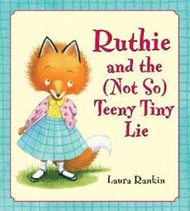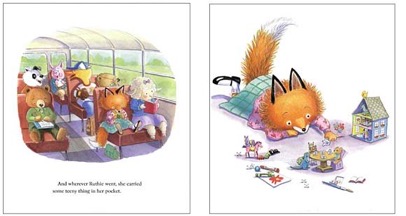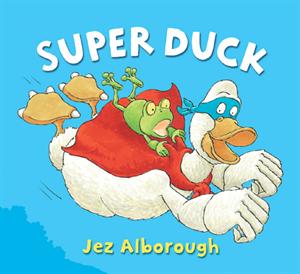Pout-Pout Fish
Speaking of books that go on repeat, The Pout-Pout Fish gets the honor of 2 or 3 read-throughs in one sitting as well! Fortunately, i love this book as well! Another great one from 2008 that is standing the test of time, and I'm sure will continue to do so. His first book success may have gone to his head, because you can find all kinds of Pout-Pout Fish stories these days, however I am a bit loyal to the original!
While I love the rhyme and lessons that Deborah Diesen creates using Pout-Pout Fish, If you haven't had a chance to pick it up, go with the original story first! You'll love all his sea creature friends and their rhyming rhythms giving him advice on how to change his attitude! Of course it all ends up being a matter of perspective and one someone to come along and bring out the positive side! If you find that your tot just won't let you put the book down, try some of these activities to spice things up!
- Look at the illustrations: There are fish, crabs, shells, and sea creatures to count. Notice the different facial expressions of Pout-Pout Fish's advisors. See if your tot can predict what will be on the next page after looking at the triptychs on right page.
- Play with facial expressions: Whether you draw or take photos of each other, play with how your face changes to show different emotions. You might find that your tot can't distinguish between certain emotions, like the subtle difference between surprised and scared, so point out the distinctions.
- Make some sea creatures: There are wonderful ideas on pinterest for lots of different sea creatures, so check out my pinterest board for some inspiration, but for a quick idea, try making a shimmery fish with foil.
- Pretend to be an octopus: Collect some suction cups and see what you can stick to, then strengthen your tot's fine motor skills with trying to unstick the suction cups. Dig a little deeper and explore why they stick to some things and not others. What do they need to create suction?
- Discuss the vocabulary: There is an abundance of new, playful words in this book. Don't be afraid to point out the new words and explore other situations to use them. Use this glossary for some help!
- Play with water: Set up a water play bin or table. See if you can get some things to sink slowly as The Pout-Pout Fish does as he says "Blub, bluuub, bluuuuuub." With some kissy lips as your bait, go fishing in the water table! All you need are some foam lips with a magnet and foam fish attached to paperclips.
- Set up a sensory bin: You can hide some fish in some colored rice or grab some different colored sea stones and shells from the dollar store to create a fun sensory experience. If you want to get a little more adventurous check out these slippery fish from Twodaloo!
- Make Jello: In a jar or in a cup, this looks like a fun snack! Shark Tank Jello!
- Play a game of tag: Depending on your group you can make this a game of kissy tag by chasing each other for kisses, or just cut out the shape of lips and add some tape, then chase each other to stick each other with a "SMOOCH!"
- Explore ocean levels: Pout-Pout Fish seems to make his way to the ocean floor, but there is so much more ocean out there than we think. Use this book as a springboard for exploring exactly how deep the ocean is. If you want to look further into ocean depth, try How Deep Is The Ocean by Anna Milbourne
Little Blue Truck
Little Blue Truck is a relatively new children's book that I predict will stand the test of time. Printed in 2008, it continues to be a favorite in homes still 8 years later. It's also one of those books that my tots ask me to read on repeat. Before we start reading the second time through, I have to set a limit, "Mommy is only reading this 3 times for now." Little Blue Truck is a fun read with lots of noises to make all while teaching a lesson about friendship. If your tots are anything like mine, they'll appreciate an extended focus on this delightful book. Let's see what fun we can have!
- Focus on noises: Talk about the noises of the animals and the trucks in the book, but then expand to other noises you may hear in the country or take a listening walk around your neighborhood. You could even introduce your tot to the exciting world of onomatopoeias!
- Take a closer look at the illustrations: There are lots of things to count from birds to toads falling leaves to raindrops. Notice the leaves on the trees and the changing weather and the changing expressions on the animals' faces.
- Celebrate a day of greeting people: As Little Blue Truck greets all the animals, and they greet him, experiment with greeting the people you see throughout the day. How do they respond? Notice what a difference a friendly smile makes.
- Play in the mud! Whether you have a nice patch in the yard or you need to make a sensory bin of mud, let your tots get dirty. Throw some trucks and farm animals in there and make up your own story. Just remember that a bath will wash the mess away!
- Make a play dough mud pile: Use or make brown play dough and stick cars and trucks in it, then take turns pulling them out without getting "mud" everywhere. The Chaos and The Clutter has a great recipe for chocolate play dough and some pictures of her tots playing in the "mud."
- Experiment with moving objects: What kind of objects can your tot move by pushing? pulling? What is the best way for you to help your tot and use teamwork? How does tying a rope and pulling it together help? Can you line up and push each other to push an object?
- Have a car wash: The dump and Little Blue Truck, and the animals, were quite dirty after their encounter in the mud, so pull out those sponges and get to washing! Wash your tot's toys that she played with in the mud or go all out and wash your car together!
- Make a road: Pull out some cardboard and some duct tape, or just a black marker and paper, and draw a road. Draw your own road or draw a map of the route you think Little Blue Truck took. Then of course drive your tot's cars and trucks down the road, remembering to greet those on the side of the road! There are lots of other ideas for how to make roads on my Little Blue Truck Pinterest Board.
- Paint with wheels: Grab the washable brown paint, or any color your tot desires, and dip her toy cars and trucks in it. Use cardboard or paper and zoom those cars all over. This might be another good activity to follow up with that car wash! Look at the fun that Messy Little Monster had!
- Discuss the moral of the story: Why did the animals not help The Dump when he honked? Why did Little Blue Truck help even though The Dump had been rude? Why did The Dump think he was more important? Why did the animals help when Little Blue Truck beeped for help? What did The Dump learn?
Tiny Lies


Book 6 of 40
Ruthie and the (Not So) Teeny Tiny Lie by Laura Rankin starts out with a sweet little fox who adores tiny things. She is always keeping her eye out for the tiniest of treasures, and she scores on the playground. When she finds a tiny camera, she is thrilled! However, when she learns that this camera already has an owner who was missing it, the situation becomes anything but tiny. The little fox lies about who the camera belongs to and she suffers the mental distress of knowing she has lied. She must sort out how to make things better before school the next day.
This is one of those books that discussion as you read is crucial. Ask questions as you read it the first time, and before you get to the end let your own tot decide whether the lie was right or wrong and how Ruthie should fix the situation. Children don't quite understand lies until they reach a minimum of age 3, but the utility of lying really kicks in around 4 or 5. Sometimes kids don't realize they are lying because they can't differentiate between how they really wanted things to happen and how they actually happened. In this case, it seems that Ruthie knew the difference immediately, yet struggled with how to come clean. What a great book to use to talk about the importance of being honest and having the courage to tell the truth!
While the focus of this book is on the actual lie itself, there are other lessons to be learned and fun to be had!
- Observe tiny creatures: You might need a magnifying glass, but head outside and see if you can find any ants or other tiny bugs and watch them for a few minutes. Talk about what they may be doing or where they may be going
- Go on a tiny treasure hunt: Inside or outside make a list of tiny things you may find or look for a list of shapes but they all have to be a on tiny things i.e. hearts on a clover or ovals on a flower petal. You could even avoid the list all together and see what bits and pieces you can find laying around outside. Remember to stay close to your tot as she is searching because we know how tots like to explore with all their senses, including taste!
- Make a bite-size meal: Grab some pre-made frozen items or make your own, but enjoy whatever tiny food your little heart desires! Mini pancakes, mini waffles, mini quiches, mini muffins, mini hotdogs, mini tacos, mini grilled cheese, mini burgers…
- Let your tot play photographer: Help your tot use your camera or camera phone to snap shots of what she sees. Alternatively you can craft a matchbox camera and write down or draw what she sees.
- Make a tiny photobook or craft: If you let your tot take some pictures, consider making a tiny photobook with those photos. If you didn't let your tot play photographer, you can still curate your own photos for a tiny photobook. Or look at my pinterest board and choose a tiny craft to do :)
- Talk about the idea of "finders keepers": Just because Ruthie found the tiny camera, does that mean it should be hers? What if you find something at the park, do you get to keep it and take it home because you found it? What would you want someone who found your toy at the park to do?
- Role play the conflict between Martin and Ruthie and discuss better options: Could Martin have said something better than "Hey, that's my camera!"? Could Ruthie have said something better to Martin instead of "No it's not, it's mine!"? What could they have done to not get so mad at each other?
- Draw a picture of how lying makes you feel: How does your face feel? How does your heart feel? How does your tummy feel?
- Do an object lesson on lying: There is the salt on the ice cream option or an option using quarters, water, and pennies
- Define courage: What was Ruthie afraid of that she had to have courage to do? What do you need courage to do?
What If You LOVE It?!
We're taking a quick look back at Jonathan James and the Whatif Monster. Michelle Nelson-Schmidt has a goal to empower children to believe in what they can offer the world, and this little monster is here to help. What better book to feature today on Valentine's Day than a story about a boy learning to take a risk on loving himself and others?!
Michelle Nelson-Schmidt recently released a free ebook of fun activities to do along with reading her commonly therapeutic book, but I'll also remind you of the activities that I suggested back in October
- Talk about you fears and ask your tot about his/her's. Then come up with ways to cope with those worries, and encourage always communicating those thoughts to a confidant—parent, friend, teacher, or even little green monster! And of course, remind your tot to think of all the positive possibilities of those fears as well.
- Take a risk: take part in a race, make a new friend at the park, try a new food, or even learn a new skill. The world is your oyster! Acknowledge the hesitance and why it feels like a risk, then think of all the wonderful possibilities.
- Make Whatif Monster ears. Thankfully that little green monster, as inspiring as he is, isn't too complicated to sketch. He has easy shapes to replicate, especially those triangle ears. So grab some green and yellow materials (white paper and markers, colored construction paper, or felt), cut your triangles and attach them to a headband or a strip of paper. Voila! You're a Whatif Monster, and now you could even role play to talk about worries.
- Consider making a calming jar, if you don't have a plush Whatif Monster at home! Reuse a plastic water bottle, fill it up with hot water and clear glue, toss in some glitter(green and gold if you're feeling the theme). Seal it up, and have a conversation about knowing when your mind and body need a break and explain that you are there to help your tot through those feelings.
- Make a worry jar: for a bit more concrete activity grab a jar, decorate it, and when a worry comes up, write it down and stuff it in the jar! You could even decorate the jar like Michelle Nelson-Schmidt's Whatif Monster and feed him your worries
Don't Forget the Fairies!
If you didn't consider Where Do Fairies Go When it Snows? with us in October, it's not too late to read along and be inspired to provide a warm haven for the hard-working pixies! While fairy home building may not be on your list with this book, I offered several other ideas in my post in the fall, so here is a refresher:
1. Take Time for Questions
Before even opening the book, ask your tot to answer the first question posed. Where DO fairies go when it snows? As you read the book, be sure to let your tot answer the questions asked and to pose her own questions about fairy habits.
2. Look Closely At The Illustrations
There are so many details to note in the illustrations of Where Do Fairies Go When It Snows? First of all, everything is just so cute. I want to put one of those little fairies in my pocket! I wouldn't be opposed to purchasing a little fairy doll with the likeness of these adorable little creatures created by Hazel Mitchell. Look at the different fairies, study the different fairy homes, and keep an eye out for recurring characters (ladybug and bunny for sure).
3. Study the Seasons
As you ponder what fairies do in the cold weather, there are a few mentions of the other seasons. What a great jumping off point to discuss the seasons and the changes that go along with them. What happens to the weather during the different seasons, how do your activities change, how does your mood change? Although those changes may be a little harder to recognize here in Southern California, the discussion is still valid :) Check out my pinterest board for ideas of activities to study the seasons.
4, Learn About Hibernation
Do fairies hibernate? Perhaps. Perhaps the fairies are getting animals ready for their long winter's nap. These musing create another wonderful springboard for a study of hibernation, what is it? And which animals do so and how do they do so? How do animals stay warm when it's cold? Here are some ideas for hibernation studies, as well!
5. Store Up Some Food
When the fairies help prepare animals for snow, do they collect food for them? You may have discussed what kind of food animals store up for winter in your study of hibernation, but what about discussing what kinds of food people used to and do now store up for winter. It's time to get in the kitchen with your tot to make some soups and jams!
6. Let Your Imagination Run Wild
If this story does nothing else, it will absolutely inspire an imagination adventure! With each question you and your tot can add so much more to the story. What kind of fairy towns do you think fairies visit in the summer? What would their celebration songs sound like? You can pose questions and answer with discussion, drawings, crafts, or maybe even write your own little fairy adventure!
7. Go On A Nature Walk
What would a reading of this outdoorsy book be without incorporating a nature walk. If not for finding fairies, at least for finding items that could be their jackets, mittens, and hats. Walk along and look for little burrows that could be a warm place for a fairy to take refuge. Look for acorn tops to be fairy hats. Stop and listen to the sounds of the world around you. Collect leaves and sticks to add to your own fairy home.
8. Invite Fairies Into Your Home
Serendipitously, I stumbled upon this adorable product just before I got the files for Where Do Fairies Go When It Snows? An entrepreneurial mother, who was inspired by her desire to keep her daughters' imaginations strong, designed Lil' Fairy Doors. These are so cute to add to your little fairy-lover's room. Just imagine how warm and cozy your local fairies will be with such a welcoming into your home.
9. Make Some Fairy Food
As Liza Gardner Walsh suggests at the end of her inquiry, make some tasty snacks for your winter-laden fairies. Of course the peanut butter toast covered in birdseed ccand the string of dried fruit will be wonderful for the little pixies, but don't forget about your little tot fairy. I hear that fairies like pancakes, so whip up a batch for your tot and save a few for the fairies too!
10. Help Each Other
Although the lesson may be concise and perhaps missed, be sure that your tot understands: fairies help others. Remind your little one to keep her eye out for ways to help others, because kind acts will warm those chilly fairies from the inside out! Here are some ideas for how to let little hands make a big difference.
Remember to SHARE, COMMENT, and LIKE because WEDNESDAY will be our first FREE BOOK Giveaway! Use #totbookclub
Revisiting Super Duck
With our recent renovations, most of our books were stored, so when Super Duck reappeared this week Tot 2 begged to read it again…and again…and again :) We hurled the kite up in the air and bumped and thumped in the truck and landed in the slop. It's such a fun book to encourage movement. We've recently had some awesome winds, so next time they stir up, we'll have to grab our copy of Super Duck and do some kite flying!
Here's a reminder of activities to do as you read this book on repeat as my Tots tend never to tire of the antics of Super Duck!
1. Make superhero costumes
2. Get up and move and act out the story
3. Visit a bog
4. Experiment with making a kite
5. Become a hero in your community
6. Eat dirt

Remember to SHARE, COMMENT, and LIKE because WEDNESDAY will be our first FREE BOOK Giveaway!
I Love Andrea Beaty!
Back to where it all began with Happy Birthday Madame Chapeau! My tots still adore this book, and I'd love to revisit it with them. The illustrations are beautiful with so many details to discuss, the rhythm is entrancing, and the story is heart-warming. Andrea Beaty hasn't missed on a book I've seen from her yet including Madame Chapeau, Rosie Revere Engineer, and Iggy Peck Architect. I'm anticipating her next book due out in September 2016, Ada Twist Scientist. I'll be getting that one on pre-order!
Have you read her books? Which one is your favorite?
15 Learning Experiences from Happy Birthday Madame Chapeau
- Make hats
- Study illustrations
- Finish rhymes
- Visit to a boutique
- Add some French words to your vocabulary
- Bring someone cheer
- Taste test different cheeses
- Celebrate with sorbet
- Perform a folk dance
- Measure hats and heads
- Play Crow and Madame Chapeau
- Investigate hats from around the world
- Pretend to be a mime
- Explore the author's website
- Discuss if Madame Chapeau could have retrieved her hat from the crow
Back with a Vengeance and FREE BOOKS
How do you get entered into the drawing? Just LIKE, SHARE, and COMMENT on my posts. It's that easy!
Who is ready to create a habit of reading aloud everyday? What books would you like to see me feature?
For now, be encouraged by Dr. Hutton about reading to your wiggle worms!
